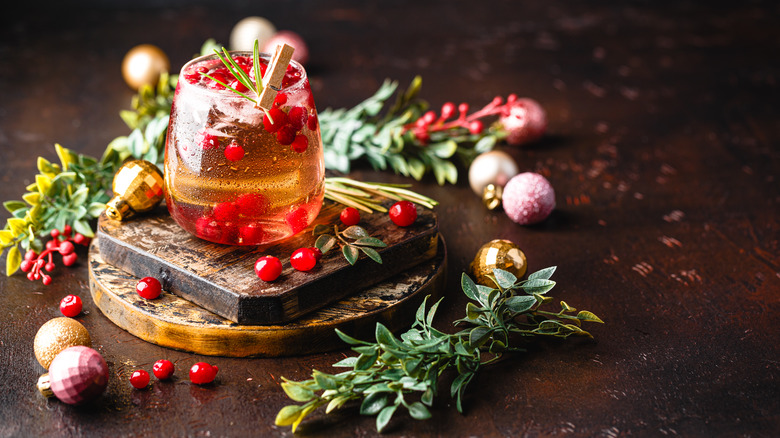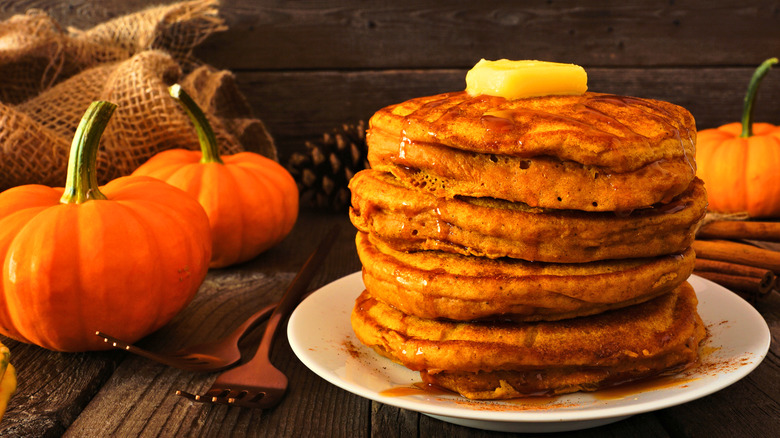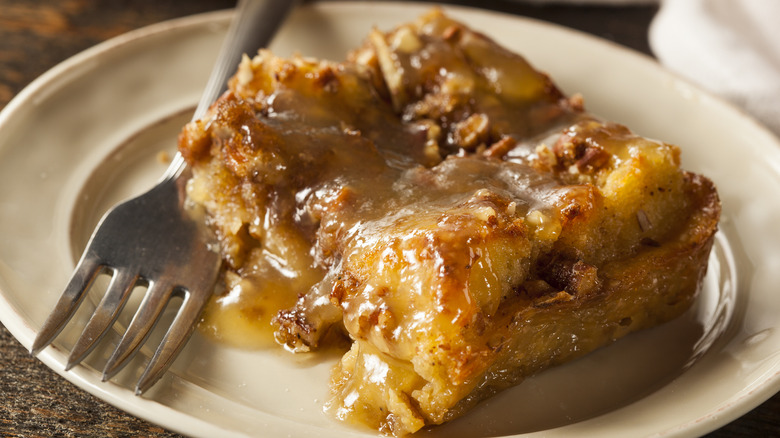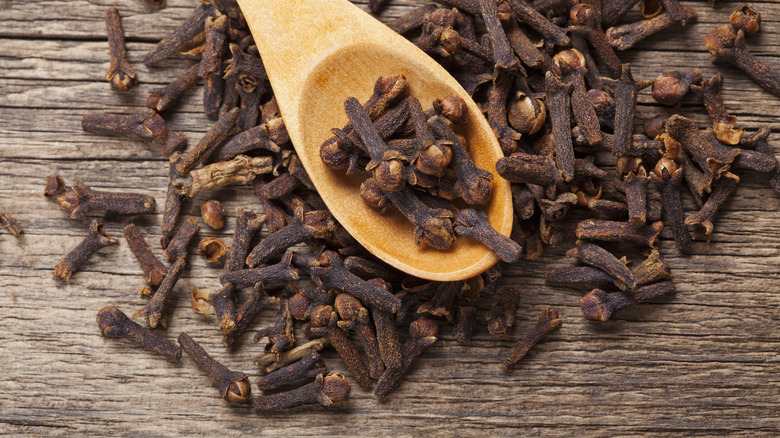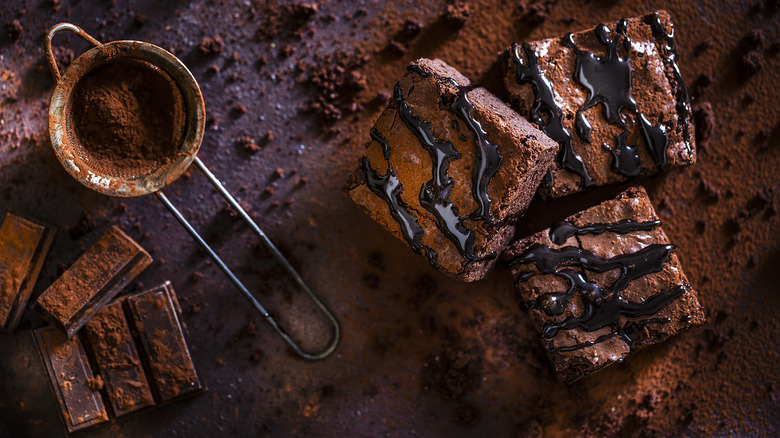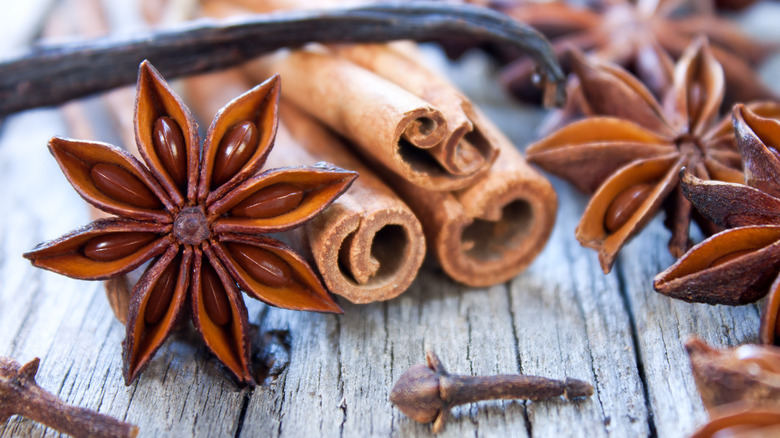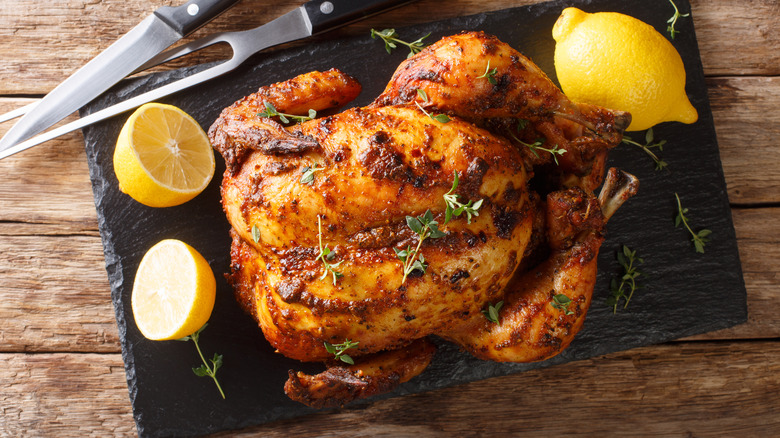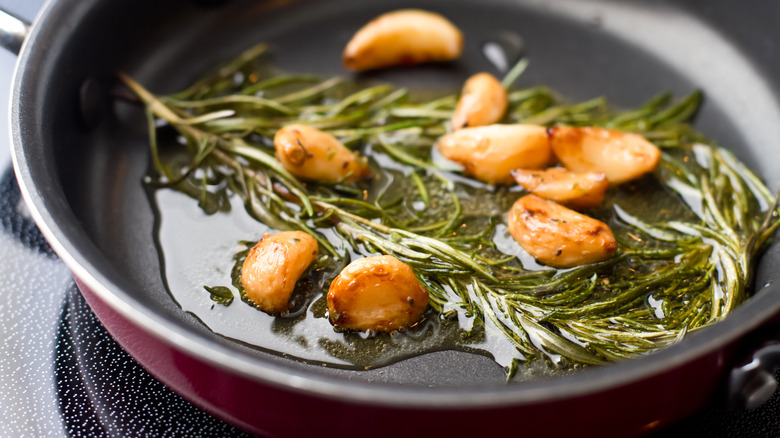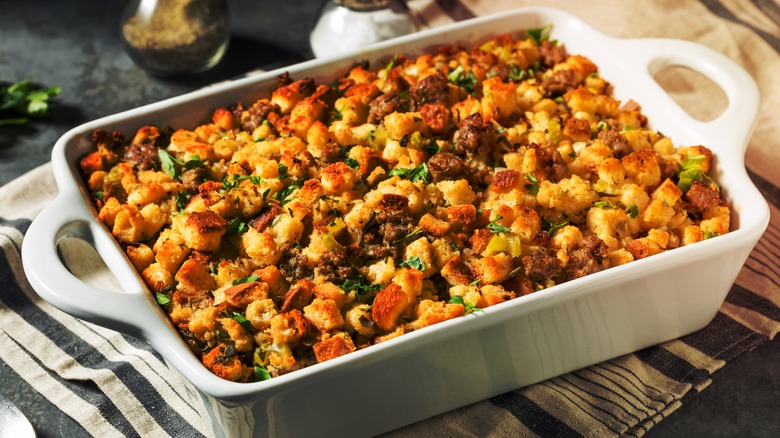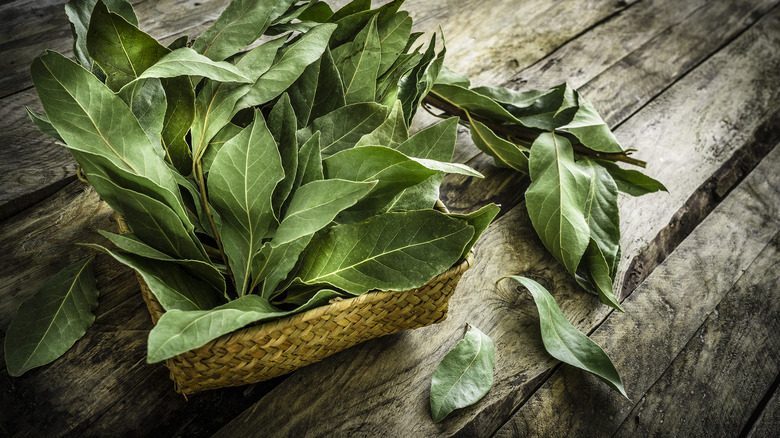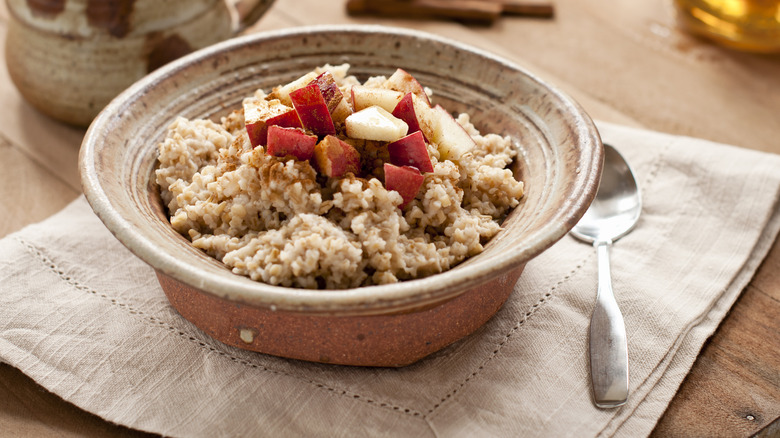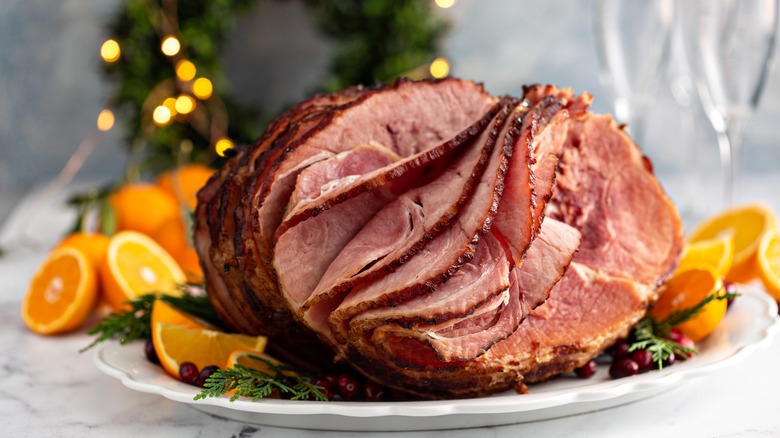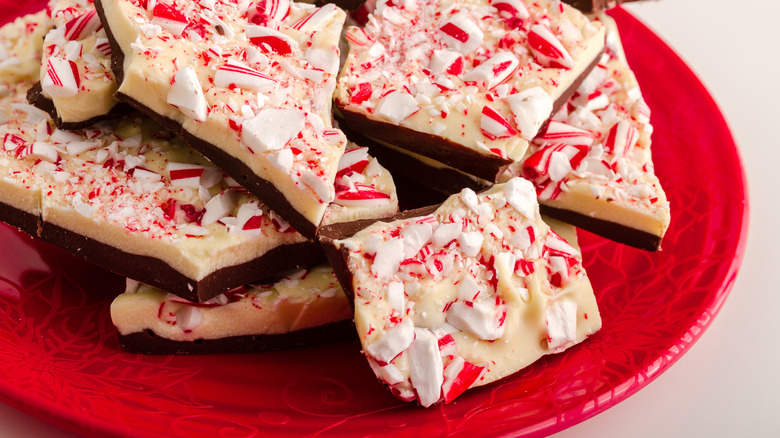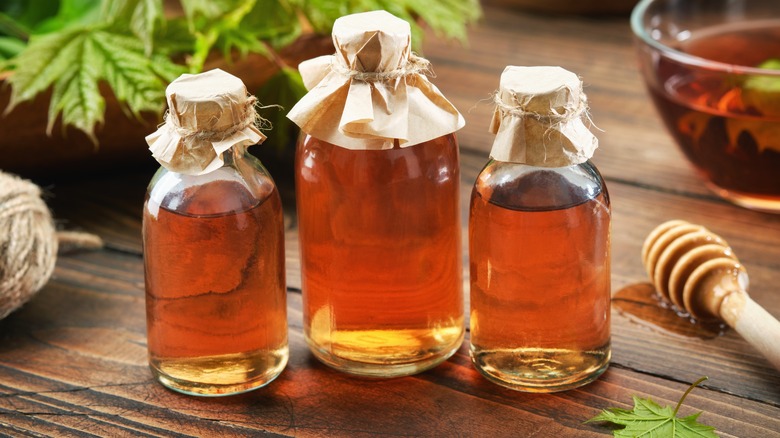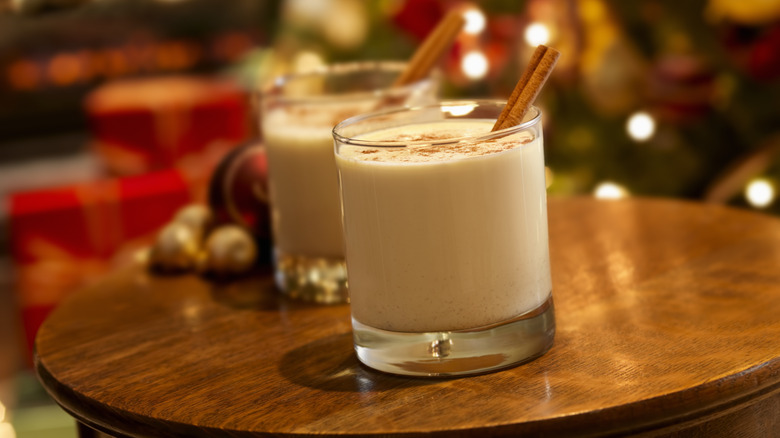Festive Spices And How To Use Them In Your Holiday Cooking
Looking for festive ways to impart the flavor of the holidays into your next meal? Look no further than this post! In the whirlwind of preparing for the holidays, it can sometimes feel like a challenging task to pull together special dishes that reflect the flavor of the season without going overboard with your time, effort, and money. Thankfully, there are a few simple spices and flavorings out there that can take your holiday entrees and baked goods from drab to fab in an instant -– and what's not to love about that?
In this post, you'll find a hodgepodge of spices that we believe will provide major upgrades to your holiday cooking and baking this season. Please note that while most of the ingredients mentioned here are spices in their true form, some only reside in your spice cabinet but may not technically be considered a spice. Either way, consider these additions worthy of the next Christmas dinner or holiday bake-off -– so pull out your grocery list and get ready. We're ready to spice things up right now!
Ginger
There are multiple ways to use ginger when it comes to holiday cooking. Though your mind likely goes to gingerbread cookies, the truth is that there are more ways than simple desserts to utilize ginger for holiday hosting.
Consider making a festive cranberry ginger ale drink, for example. By combining this simple spice with ginger ale, cranberry juice, cinnamon, and star anise, you can dole out a spicily merry red-hued drink to wow your guests. Pour into elegant glasses and garnish with cinnamon sticks, orange slices, fresh cranberries, or whatever else strikes your fancy for a refreshing holiday sip.
In addition, you may want to consider using ginger in your savory dishes. Entrees like pork tenderloin, roast beef, and even turkey can benefit from this spice, although we do admit this would be quite an eclectic addition. Either way, use ground, pureed, sliced, or freshly grated versions of this zesty spice to give your holiday a zingy kick outside of standard gingerbread cookies. Enjoy!
Cinnamon
Cinnamon is a commonly used spice in baking, and indeed, it works perfectly for the holiday season. Cinnamon makes for impeccable warmth on cold wintery days, and thankfully, there are a million ways to implement it into your holiday cooking.
One of our favorite ways to use the spice is to make cinnamon rolls. You can easily find an overnight cinnamon roll recipe that allows you to whip up a batch of dough to sit overnight before popping it in the oven to enjoy rolls on Christmas morning. To add to that, pairing cinnamon with hot chocolate, apple cider, or traditional chocolate chip cookies can give these familiar eats an interesting twist that we're certain you and your family will love.
Be sure to note that there are several versions of cinnamon available, with the most common being cassia. Other cinnamon types, such as Ceylon, are available online and in specialty stores, and both types can offer health benefits in small doses. Buy cinnamon in powder form for baking, but using it in stick form is an excellent option when adding this spice to liquid.
Allspice
Although most people think of allspice as a blend of multiple spices, its truest form is actually made with a single ingredient. Coming from the dried berries of a plant from the myrtle family, this spice emulates the flavor of multiple warming spices mixed together. Because of this, it is possible to imitate the flavor of allspice on your own by using cinnamon, nutmeg, and clove as your base in holiday cooking.
With that said, you may be wondering how to use this spice when cooking and baking. As those of you familiar with allspice know, it can be a rather pungent ingredient and can give your dish a very distinct flavor. Because of this, subtlety is crucial, especially when using it in savory dishes. Try adding a pinch or two to a classic chili or adding a bit to pumpkin pancakes. The flavor of allspice just screams warmth during chilly weather and melds beautifully with other warming spices when making desserts and entrees for the holidays.
Nutmeg
Nutmeg is one of those spices that you either love or hate. No matter which side of the coin you land on, you'll likely associate its flavors with the warmth of baking and possibly one of your grandmother's old-fashioned recipes from long ago. Nevertheless, this unique-tasting spice can make its appearance in several modern holiday meals, from drinks to baked goods and even breakfast fare.
For example, nutmeg is often a common secret ingredient found in egg dishes. Because its flavor is so pungent, only a little is needed, but it provides an unexpectedly flavorful backdrop to traditional eggs that can upgrade them to be the star of your next holiday breakfast. You can also find nutmeg used in common holiday recipes, including eggnog, bread pudding, and more. Want something to amplify the flavor of your Thanksgiving or Christmas turkey? Try adding a bit of nutmeg to your traditional spice rub along with some sage to balance the flavor, and you'll have a beautifully spiced entree to impress all your hungry dinner guests!
Clove
Clove is similar to allspice, but to us, the taste is a bit sharper. Like allspice, clove complements both sweet and savory flavors and can show up in a variety of recipes for holiday cooking. One of our favorite ways to utilize clove is to make spiced cider with it. Combine regular apple cider with a variety of spices, including cinnamon, nutmeg, cinnamon sticks, and of course, the cloves. You can use whole cloves or ground, but which version you choose will really depend on your recipe. If you choose to use ground cloves in place of whole cloves in a recipe, be sure to scale back on the amount since ground cloves tend to yield a more potent flavor.
Other ways to use clove include flavoring gingerbread muffins or combining it with cider and bourbon to create a delightful glaze for your next Christmas ham. No matter which way you use it, be sure not to go overboard -– just like with allspice and so many other spices on this list, using too much may end up overpowering your dish.
Cocoa powder
You probably think we're going to suggest that you use cocoa powder in hot chocolate here, and in part, you're right. Cocoa powder does make for an excellent, easy, and additive-free hot cocoa, but that doesn't mean it's the only way to use it for your winter holiday cooking. Some more surprising ways to use cocoa powder would be to make an especially decadent Christmas chocolate cake, Christmas fudge, brownies, or our personal favorite, chili seasoned with cocoa powder.
Yes, you heard that right. You can actually make chili using cocoa powder, and it's oddly satisfying. The depth of the cocoa adds something uniquely different to the flavor profile of chili that we think is perfect for colder months. It also makes for a great talking point when you dish up this curiously dark, rich, and decadent meal for guests to enjoy.
When selecting the cocoa powder you'll use, know that there are several available for your choosing. Cacao, cocoa, and Dutch-processed cocoa are all different, so be sure to familiarize yourself with each before deciding which will be the best for you and your particular holiday recipe.
Star anise
If you aren't already familiar with this spice, you may be left a little confused as to what it is and how it should be used. Much like some of the other warm and sharp spices on this list, star anise adds its own distinct flavor to holiday treats and eats that make it literally the "star" of the show -– if you like its taste, that is.
Star anise is known for its potent, somewhat sweet and licorice-esque flavor, which can often be an acquired taste. Some chefs, like author and TV personality Carla Hall, include it in a spiced holiday turkey, while others use it to spice up chai or Christmas cookies. Know that it comes in both powdered and whole varieties, so it'll be up to you to choose which form will work best with the recipe.
Bear in mind that star anise may not be as inexpensive as other spices on this list, but if you truly love the taste, that price point likely won't matter to you. Grab a jar this holiday season, and see what you think!
Thyme
You knew this one would end up on the list, didn't you? Thyme works so well for so many dishes; indeed, it is a show-stopping herbal addition when cooking savory entrees for the holiday. Use it to flavor a variety of meats, including chicken and roast beef, or to spice up tomato-based dishes that pair perfectly with pasta for a rich and filling Christmas Eve meal with some Italian charm. This is also another one of those herbs perfect for stuffing the cavity of your turkey to impart an herbal essence to your meal without coming off too overpowering — yes, please!
Oh, and lest you think thyme is reserved only for meat entrees, think again. Thyme has been known to make an appearance even in cookies if you can believe it. Its herbal flavor profile can prove a win for balancing out sweet flavors in cookies, yielding a surprisingly enjoyable treat that's a true deviation from the typical holiday norm.
Rosemary
Along with the aforementioned spice is its milder and sweeter herbal cousin, rosemary, which is a wonderful option for flavoring holiday dishes. Like thyme, rosemary can be used to flavor savory entrees and pastas, but it can also be used to make savory or sweet cookies and more. Rosemary is readily available in most supermarkets in various forms, meaning you'll have a lot of versatility in the way you use it and can also control the strength to which it gives off its flavor.
Fresh rosemary, for example, won't be as pungent as dried, and dried rosemary leaves won't be as concentrated as rosemary in powdered form. There is no guarantee that you'll find all forms of rosemary at your local grocer, so you may have to use what is available and make adjustments to your holiday recipe as needed. Just know that using rosemary when cooking works as a pleasing and aromatic way to celebrate nearly any holiday.
Sage
Sage is in a league all its own when it comes to herbs, as its uniquely smoky yet sweet taste pairs so well with so many yummy holiday dishes. Use sage when making a Christmas chicken, or better yet, sneak some of it into your next homemade stuffing. Sage also pairs nicely with pork — hence the reason you'll often find it flavoring your sausages — so take full advantage of its delicious essence when preparing a pork-based holiday meal.
When scouting sage at a grocery store, note that it comes in a variety of forms. Rubbed sage is derived from dried and rubbed sage leaves that produce a loose and fine mixture good for flavoring your holiday dinner. Ground sage is sold after the leaves are completely pulverized, leaving nothing but delicate dust. You can also buy sage fresh and intact for stuffing a turkey cavity or flavoring your gravy. It's one of our favorite seasonings during the holiday season, and we're confident you'll love using it, too.
Bay leaf
Fresh or dried bay leaves are often used as a central herb to deepen the flavors of slow-cooked dishes. Celebrity chef Rachel Ray has been spotted using up to six of these bad boys when whipping up her herb-roasted turkey recipe, and we've even found a dreamy glaze to use for Christmas ham or chicken utilizing the essence of bay leaf flavor.
So, what is it about bay leaves that makes them so popular? They're typically used to amplify flavors and, when in their dried form, often mimic the taste of thyme, eucalyptus, or menthol-like ingredients. Bay leaf is often added to slow-simmering or roasting dishes, including chili beans, soups, and other delicious meals that would make perfect additions to your holiday lineup. Know also that bay leaves can be used to essence baked goods, though they aren't as common this way. We found a recipe for using bay leaves in pound cake that got rave reviews, so we can say with confidence that this is one herbal seasoning you can employ for both sweet and savory dishes with lovely results.
Apple spice
Sometimes, cooking for the holidays means more than waiting for a specific day to arrive. Why not simply infuse all the wonderful flavors of the holiday season into everyday cooking instead? Though apple spice certainly can be used for several wonderful holiday meals, this spice can just as easily be incorporated on a daily basis into a variety of recipes to usher in the joy of the new season.
Take sprinkling apple spice over oatmeal, for example. Though it's not a mind-blowing oatmeal hack, we think most would agree that oatmeal needs a bit of sprucing up at times. Prepare oatmeal the way you normally would, and sprinkle a little of this delicious spice on top to make it extra special. You could also consider sauteing some apples with honey and apple spice and adding them to your oatmeal.
Another great way to use apple spice is over French toast, crepes, and pancakes. Simply sprinkle on top (or heck, even in the batter) the same way you might cinnamon. Enjoy this scrumptiously enticing way to wake up either on Christmas morning — or every morning. Why not?
Dried orange peel
Using dried orange peel, aka orange zest, is another awesome way to ring in the holiday season when it comes to festive cooking. Orange zest, like lemon zest, has multiple uses and can even be used spontaneously when you wish to add a bit of sweet zing to meals.
One great way to use orange zest is in your cranberry sauce. You can use it to flavor the sauce itself and add a little extra as a garnish at the end. You can also use grated orange peel for common holiday entrees like ham, along with other flavoring agents like brown sugar, mustard, and orange juice to produce a cheery and flavorful result that you and your family won't be able to get enough of.
And while you could buy orange peel at the grocery store, you could just as easily make your own at home, and for a lot cheaper, we might add. Simply grab a hand–held grater and grate across the skins of your orange over a plate. Once you've used the amount of orange zest you want, set aside your leftovers and freeze them in a freezer-safe container or bag for up to three months. It's really that easy!
Peppermint extract
Peppermint extract isn't a spice. We get that. But it does go in your spice cabinet, and it totally works to provide a blast of minty freshness most of us can't help but associate with the holidays. Using peppermint extract in both baked goods and decadent holiday drinks is a great way to kick off the end-of-the-year shenanigans, so it's important to keep a stash of it around when the holiday season arrives.
Try your hand at homemade peppermint bark or shake things up a bit with a tasty homemade peppermint milkshake. Of course, we all know you can add peppermint extract to your morning brew or hot chocolate, though do be mindful of how much you use. About ¼ teaspoon of mint extract in a single-serve mocha or hot chocolate recipe should do it; otherwise, you risk making your concoctions a little too potent.
When on the hunt for peppermint extract in the grocery aisle, it shouldn't be too hard to find. Just remember that mint and peppermint extract exist, and one may taste slightly different than the other. Traditional mint is a little more subtle than the peppery zing of peppermint, so choose according to your palate, and get crackin' on the holiday cooking!
Maple extract
This is technically another nonspice, but can we all just agree that the rich, robust, and warm flavor of maple simply cannot be beat? Seriously, we cannot get enough of the decadently comforting essence that maple always brings. And while we prefer natural maple flavorings acquired from pure maple syrup, sometimes you need a bit of the concentrated stuff (i.e. maple extract) to take the flavor up and over the edge.
So, how is maple extract used? Oh, let us count the ways! One awesome way is to make maple pudding. You'll utilize maple extract, cornstarch, egg yolks, half and half, along with a variety of other spices and ingredients to whip up a holiday treat that's truly marvelous. Another way to use it is to add it to your sweet potato pie, which only further amplifies that already sweet, buttery, and decadent taste that dish usually brings.
Try these ideas and more to bring out that wow factor you're after this holiday season –- we're getting hungry just thinking about it!
Vanilla extract
Vanilla extract may seem hum-drum, and indeed, we admit that it's likely something you already keep stashed in your pantry all year long. And while we know vanilla extract isn't technically a spice, its addition to certain dishes, especially around the holidays, is a true necessity.
Apple cakes, danishes, whipped cream, sugar cookies, cheesecake, eggnog, you name it; they all require vanilla extract, and yes, you'll likely taste the difference if you leave it out of your recipe. Also, you'll want to make note that not all vanilla extracts are made equally. As you likely already know, there are some imitation varieties available that are much cheaper than the real deal, and they will usually taste different, too. You also may see Madagascar vanilla and more on the shelf, so be sure to research ahead of time to know which vanilla extract is the right pick for you.

